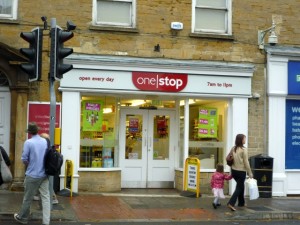Has Britain fallen out of love with Tesco?
Today’s release of fairly weak UK trading figures from Tesco – where like-for-like sales, excluding petrol and VAT, fell by 0.5% in the first half of the year – has unsurprisingly prompted much media discussion, both about Tesco specifically and the state of the UK economy more generally.
Tesco’s coverage hasn’t been helped by rival grocer Sainsbury’s revealing that its own like-for-like sales, excluding petrol but not VAT, rose by 1.9% in the first six months of the financial year (a measure for which the equivalent at Tesco was a 0.5% rise).
As new Tesco boss Philip Clarke noted, there’s no doubt that retailers across the spectrum are having to eke every penny of spend out of cautious shoppers at the moment, with further gloomy figures on household consumption released today. The big question, however, is why the UK performance of Tesco – a retailer that has long been the behemoth of the British supermarket sector – is seemingly lagging behind that of major rivals such as Sainsbury’s.
Before trying to answer that question, it’s worth reminding ourselves that Tesco as a whole remains a phenomenally successful business. Today’s figures showed that the company made a profit of £1.9bn in the first half of the year, on group sales of £35.5bn – a performance that most retailers can only dream of. Tesco’s store estate comprises more than 5,300 shops – half of those overseas – and it is now the third biggest retailer in the world, with a strong presence in Ireland, eastern Europe, Asia and the US. And for all that its UK performance is below par, Tesco’s market share remains more than that of Asda and Morrisons combined – thanks in no small part to the efforts of its 200,000 UK staff. As a homegrown international success story, Tesco has given the UK much to be proud of.
However, it’s the business’s very immensity that also contributes to some of its present challenges. The perception that Tesco is simply too big – and too powerful – is widely held, not least here in the North East where it owns much of Gateshead town centre and holds the key to the centre’s long-awaited regeneration. There are clearly some shoppers who refuse to shop at Tesco for that reason.
In the UK, a significant chunk of Tesco’s growth in recent years has been built on expansion in non-food. This served the business well in the good times, but has arguably left it more exposed than its rivals now that discretionary spend is under pressure. There is also, I would suggest, some sense that Tesco’s expansion into new categories – whether that’s non-food, banking or used cars – has allowed others, such as Waitrose and the hard discounters, to up their game and become the innovators in the core grocery business.
I touched upon some of Tesco’s challenges in grocery when I recently blogged about the Asda Price Guarantee, and Tesco, like Asda, is having to fend off rivals at both the premium and value ends of the market. For all its investment in price – including the eyecatching Price Drop campaign announced last month – my reckoning is that Tesco still faces an uphill struggle to be perceived as cheaper than Aldi, Lidl or even Asda. The proliferation of higher-priced Tesco Express stores – and the growth of the supposedly even dearer One Stop ‘stealth fascia’ – surely don’t help this perception. In contrast, Asda’s clear message about charging the same prices in its smaller stores as in the larger ones helps to cement its own value credentials.
What about quality? Here too, Tesco arguably has work to do. Just among my own circles of friends, I often hear perceptions of Morrisons being better than Tesco in fresh produce; Sainsbury’s as being a more ‘upmarket’ shop in general; and Waitrose – still a relatively recent entrant to ‘the North’ – as excelling in speciality products and treats. In contrast, Tesco’s dalliance with being ‘Britain’s biggest discounter’ and its recent launch of ‘venture brands’ – its own in-house products, but without a Tesco branding – overlaid with the familiar Value, mid-tier and Finest ranges, arguably create a confused picture of what Tesco stands for.
The one area where Tesco beats all its rivals is its long-established loyalty scheme, Tesco Clubcard. Reportedly boasting 15 million active cardholders, Clubcard provides the retailer with an unrivalled snapshot of UK consumers’ shopping habits, as well as a means of communicating targeted news and offers to its customers. Given the importance of Clubcard, the decision last week to scrap the Double Points promotion – and invest the money saved in immediate Price Drop reductions – is a bold if risky one. Tesco’s reckoning, perhaps, is that investing in loyalty is only worthwhile if shoppers are actually loyal – and don’t go off to Aldi, Lidl, Morrisons or Waitrose instead.
Back in the days when Prunella Scales’ Dotty was the face of Tesco’s TV advertising, there was a warmth and clarity about the Tesco brand – and even an affection for it – that has got rather lost in the intervening years. Today, Tesco’s rather cold and soulless stores seem like a metaphor for the brand.
Whether the recently announced initiatives will clarify what Tesco stands for – and win back those customers who have started to establish new shopping habits elsewhere – remains to be seen. However, given Tesco’s deep pockets, immense experience as a retailer, and past record of success, only a brave observer would write off its present efforts to bring the UK business back on track.















Also another thing to add to this. Tesco don’t seem to have caught on that many shoppers are “smart shopping” these days, especially people like me who need certain brands and will look online first on sites such as mysupermarket.com and see where that product is cheapest and tailor the grocery shopping trip around it. If I need catfood and my cats’ fave brands is on offer in Sainsburys then I’ll have a walk down there.
Since the advent of the recession my shopping basket will be 75% offers and 25% core products. Being in an area with two major supermarkets in close proximity of each other (Asda and Sainsburys), I can easily pick up most of my shopping on loss leading offers because I have the flexibility to be able to walk to either store quite easily. Tesco tend to be out of town these days and their local stores are a heck of a lot dearer than their counterparts Asda. There are occasionally too good to miss offers on at Tesco but because it’s so big, such an effort to visit and a fivers petrol there and back you don’t really make any savings in the long term and Asda’s day to day grocery range at good prices coupled with their 3 for £10 wine offers are always better value than anything Tesco can offer.
As a household that purchases about 8-10 bottles of wine a week, I would rather spend £30 in Asda than £45 in Tesco for the same product. It’s massive difference
Being in the North East too, I hate the Kingston Park Newcastle Branch with a vengance. I only go there when it’s absolutely necessary which is approximately 4 times a year
Definitely true that Tesco’s become soulless; I remember those Prunella Scales adverts very fondly!